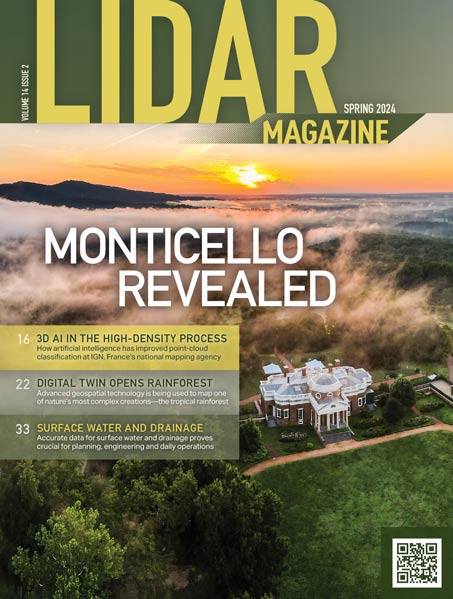Nottingham, UK, 18 September 2013 – Australian researchers have created the first ever interior 3D map of Italys iconic Leaning Tower of Pisa by using a breakthrough mobile laser mapping system. Developed by the CSIRO, Australias national science agency, the Zebedee technology is a handheld 3D mapping system incorporating a laser scanner that sways on a spring to capture millions of detailed measurements of a site as fast as an operator can walk through it. Specialised software then converts the systems laser data into a detailed 3D map.
While the towers cramped stairs and complex architecture have prevented previous mapping technologies from capturing its interior, Zebedee has enabled the researchers to finally create the first comprehensive 3D map of the entire building.
This technology is ideal for cultural heritage mapping, which is usually very time consuming and labour intensive. It can often take a whole research team a number of days or weeks to map a site with the accuracy and detail of what we can produce in a few hours, said Dr Jonathan Roberts, Research Director at CSIROs Computational Informatics Division.
Within 20 minutes we were able to use Zebedee to complete an entire scan of the buildings interior. This allowed us to create a uniquely comprehensive and accurate 3D map of the towers structure and composition, including small details in the stairs and stonework.
During Project Pisa, CSIRO also collaborated with local Italian scientists from Scuola Superiore Sant’Anna (SSSA) who believe the research will have significant impact on preserving the cultural heritage of the site.
Our detailed record of the Leaning Tower of Pisa may one day be critical in being able to reconstruct the site if it was to suffer catastrophic damage due to natural disasters such as a fire or an earthquake. Having a detailed 3D model of the worlds most significant cultural heritage sites could also be used to allow people who cannot physically visit these sites to better understand and appreciate their history and architecture, said Franco Tecchia, Assistant Professor at the PERCRO – Perceptual Robotics lab.
In 2012, CSIRO through its Digital Productivity and Services Flagship worked with 3D Laser Mapping, a global developer of laser scanning solutions to commercialise the Zebedee research into the ZEB1 product. As well as its applications in cultural heritage, ZEB1 is also being used to increase efficiencies and improve productivity in a number of different industries. For example, the technology is already assisting mining companies to better manage their operations and helping security forces to quickly scan crime scenes.
About CSIRO:
CSIRO is Australias national science agency and has been pushing the edge of whats possible for more than 85 years. Today, the organisation has close to 6,500 people working out of 58 centres in Australia and internationally. These people work closely with industry and communities to leave a lasting legacy across five broad areas: food, health and life science industries; energy; environment; information and communications; and manufacturing, materials and minerals. For more information visit www.csiro.au
About Zebedee:
Zebedee is a handheld 3D mapping system developed by CSIRO that can scan an environment as an operator walks through it. The system produces a 3D map of the environment as well as an accurate record of the trajectory followed. The primary sensing technology utilised is LiDAR (Light Detection and Ranging), in which an infrared laser measures ranges to surfaces in the environment. The distinguishing feature of Zebedees design is that the laser scanner is mounted on a spring, which provides a lightweight solution for ensuring a wide scanning field of view. The spring converts the natural motions of the operator into a suitable sweeping motion of the scanner. A low-cost inertial sensor provides rough measurements of the springs rotations. Specially designed software is able to convert the raw range and inertial measurements into a 3D map in less time than it take to collect the data. The 3D maps are represented as point clouds, which consist of millions of points expressed in a common coordinate frame. For more information visit www.csiro.au
About the TeCIP Institute of Scuola Superiore Sant’Anna:
Scuola Superiore Sant’Anna is a leading Italian research university, where the Institute of Communication, Information and Perception Technologies (TeCIP Institute) was established in 2001 as a Centre of Excellence providing research and training related computer systems for embedded real-time systems, sensor networks, communication and sensing using photonic technologies, virtual environments and robotic systems. The TeCIP Institute alone counts today more than 300 employees, about 10 training initiatives – with around 150 students from all over the world attending classes and using the Institutes research facilities – and 125 operative research projects. Its main objectives are to develop high-quality scientific and technological research and innovative international training programmes at graduate level. It is organized into research three units, referring to three main scientific fields: Communication (InRete Laboratory), Embedded Systems (Real-time systems laboratory) and Perceptual Robotics (Percro Laboratory). For more information visit http://www.sssup.it/
About 3D Laser Mapping:
3D Laser Mapping is a global developer of laser scanning solutions for sectors such as mapping, mining and manufacturing. 3D Laser Mapping specialises in integrating laser scanning hardware with their own software and peripherals to create solutions at the cutting edge of technology. Through a worldwide network of distributors 3D Laser Mapping is able to provide frontline support and service for a growing international client base. For more information please visit www.3dlasermapping.com
